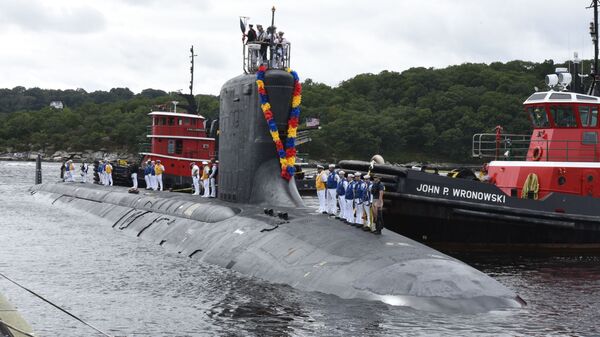They call submariners the “silent service” for a reason: in a cat-and-mouse game of acoustics deep beneath the waves, the quietest boat has the advantage. That’s why the US Navy’s newest fast-attack subs, the Virginia-class, have been fitted with a sound-absorbent outer coating: to dull the sound bouncing off their metal hulls and make them harder for enemy subs to detect.
However, according to Ari Lawrence, a senior engineer at Huntington Ingalls' Newport News Shipbuilding facility in Virginia, Huntington Ingalls and partner Northrop Grumman "falsified testing and certifications on multi-billion dollar submarine contracts,” causing the coating to be improperly applied.
The whistleblower has filed a suit against the defense contractors on behalf of the US government under the False Claims Act in the US District Court for the Middle District of Florida, Jacksonville Division. According to the complaint, the firms "knowingly and/or recklessly" filed falsified records with the US Navy showing they had applied the Special Hull Treatment to the Virginia-class subs, causing the government to “pay the defendants in-full for submarines with dangerous defects that put American lives at risk."
According to Lawrence, "Huntington Ingalls had never obtained proper qualifications and certifications for the use of TPAC [two-part adhesive coating] on the Virginia-class submarines for any applications,” which are "critical to ensure that the personnel used to mix and apply the TPAC are properly qualified and that the procedures are performed correctly.”
As a result, the coating “de-bonds,” peeling off the sub while underway. Task & Purpose, which first reported the whistleblower’s story, noted that it’s not uncommon for such layers to come off as a result of normal stressors underwater, but because the Virginia-class subs’ coating gets painted on, it tears off in uneven chunks. Other subs, such as the older Los Angeles-class, have tiles that flake off individually, causing much less of a problem.
"If you're driving around and a chunk of this comes off and is kind of dangling there, that creates a lot of noise," Bryan Clark, a senior fellow at the Center for Strategic and Budgetary Assessments and a retired submariner, told Task & Purpose.
Anechoic coating loss known issue for #US Virginia class submarines but this is worst I've seen via @DougieCoullPics https://t.co/GfQiu22gYg pic.twitter.com/jnj3TrHliX
— Joseph Dempsey (@JosephHDempsey) June 12, 2017
Noise, remember, is very bad. "The submarine being quiet is its main advantage. It's what allows it to get close to shore to deliver SEALs, shoot cruise missiles in somewhere, or to do surveillance. So that ability to get close to a target is really important,” Clark noted. "So if you do get detected, then you're limited in your ability to protect yourself, or to run away quickly.”
Lawrence also claims in the complaint that he was pressured by Huntington Ingalls to keep quiet about the issues, and that he was punished for bringing them up. Lawrence says he was flagged as a security risk, had his cell phone confiscated for four weeks, had his promotion blocked and was given bad performance reviews in 2015 after raising the alarm about the flaky filings. He also writes he was reassigned to "the 'yard' to work on his 'engineering rigor.’”
However, the problem is hardly unknown: the photos above date to 2017, but similar incidents can be found from as early as 2010, such as those featured on the blog Next Navy. An April 2011 report by the Congressional Research Service cites a June 30, 2010, memorandum from J. Michael Gilmore, Director of Operational Test and Evaluation, which noted that “Special Hull Treatment continues to debond from Virginia-class submarines during underway periods, often in large sections up to hundreds of square feet.”
A January 2011 article by the Newport News Daily Press, the town paper where Huntington Ingalls’ shipyard is located, was titled “Hull coating failures on Virginia Class submarines ‘are behind us,’ Navy says,” and notes that the Navy knew about the problem as early as 2007 on the USS Virginia, the first sub in what is today a class of 17 active boats. The Navy expects to christen its 19th Virginia, the USS Oregon, on Saturday, Military.com reported.
This is not the only problem plaguing the Virginia-class subs. Last year, improper welds were found in more than one dozen vertical launch tubes to be installed in newer Virginia-class subs. This past August, tube-maker BWX Technologies said it might have to pull out of contracts on the upcoming Columbia-class ballistic missile submarines as a result of its continued effort to fix the broken tubes in the Virginia subs.
In fact, when the keel of the USS Virginia was laid in September 1999, the final design of the boat hadn’t yet been completed. Engineers continued to tweak the design as the boat was constructed in an effort to minimize time and cost. Instead, the budget swelled by 21%, Sputnik reported. Despite this, the Navy has adopted a similar plan for the Columbia-class subs, the first of which is expected to begin construction in October 2020.
Huntington Ingalls has drawn significant flak for its work on other warships for the US Navy, too, such as the new USS Gerald R. Ford aircraft carrier, the lead ship of her class. The vessel is loaded with new technology, from an electromagnetic aircraft catapult to a new propulsion system and even new munitions elevators. However, due to one bungle after another, the behind-schedule, over-budget warship only got its engines fixed last month, and most of its weapons lifts have yet to begin working correctly, even though the ship was supposed to be delivered to the Navy in July 2017 - leading to the late Sen. John McCain to call the Ford "a spectacular debacle.”




